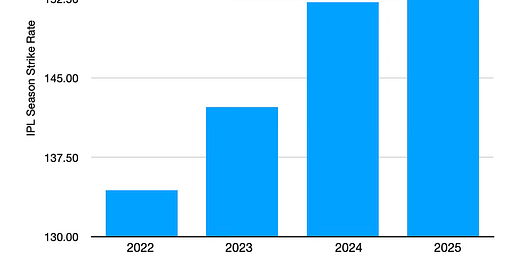How the Impact Sub Revolutionised IPL Hitting
Dramatic effect on run-scoring since the impact sub was introduced...
Currently in the third season since it was introduced to the IPL, the impact sub rule has divided opinion like little else - the cricket version of marmite, perhaps.
Some people think that the impact sub rule has caused a lack of development in all-rounders - a point of view which runs counter to last season’s data showing that genuine all-rounders such as Sunil Narine and Sam Curran have higher match involvements than any other player type, while others praise the freedom which batters now have knowing that there is an extra player who can be used as a safety net in case their team lose quick wickets.
My view on the all-rounder point is clear - I don’t think that the impact sub rule has had any issues for genuine all-rounders or all-rounders who get into teams for their primary skillset (for example, Glenn Maxwell as a batter who can contribute with off-spin, or Rashid Khan, as a world-class spinner who is capable of lower-order hitting).
What it has heralded the decline of, instead, is those ‘bits and pieces’ all-rounders who don’t get into teams for their primary skillset, but can contribute at a below-average level in multiple facets - an over or two with the ball, usually in the middle overs, and maybe some extra depth without brutal hitting at number eight or nine. These guys are pretty much done in the IPL right now, and I don’t think that’s a major loss for the league.
At the same time as the impact sub rule, there has been a significant rise in Indian domestic batting talent, and possibly more specifically, domestic hitting talent. Gone are the days of a domestic batter averaging 25-30 at 125-130 strike rate getting decent IPL contracts, and game time as a starter for teams.
Those players just aren’t necessary now, and their sub optimal usage 20-25 balls per innings (15-20% of balls available to a team) in batting resources is no longer an issue for teams to have to deal with. In the past, teams had little choice but to pick these anchors because there wasn’t enough high-intent talent to go around, but that’s not the case now.
Now, with the impact sub & a different mindset from the young batters progressing into the IPL from domestic cricket - which has definitely also helped the national team in white-ball tournaments as well - we are seeing continually higher and higher scores, driven by a rapid rise in boundary-hitting, and in particular, 6-hitting.
Given the direct relationship between boundary-hitting and strike rate, we can see how team strike rate has evolved in the IPL in recent years since the expansion to 10 teams in 2022:
Keep reading with a 7-day free trial
Subscribe to Dan’s Newsletter to keep reading this post and get 7 days of free access to the full post archives.


